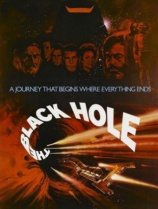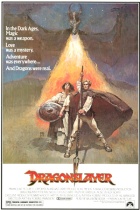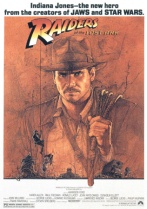 One of the great movie dragons is Vermithrax Pejorative from Dragonslayer. And guess what? She’s right there on the cover of Cinefex #6 in the form of ILM’s go-motion puppet. Inside the cover is a still of actor Peter MacNicol astride the full-size dragon head built for the film’s live-action shoot. This issue’s 80 pages contain three behind-the-scenes articles:
One of the great movie dragons is Vermithrax Pejorative from Dragonslayer. And guess what? She’s right there on the cover of Cinefex #6 in the form of ILM’s go-motion puppet. Inside the cover is a still of actor Peter MacNicol astride the full-size dragon head built for the film’s live-action shoot. This issue’s 80 pages contain three behind-the-scenes articles:
- Computer Imaging – An Apple for the Dreamsmiths (article by Peter Sørensen)
- Dragonslayer (article by S.S. Wilson)
- The Wrath of God … and Other Illusions (article by Don Shay)
Well, here it is: the first copy of Cinefex I ever bought. I picked it up from Forbidden Planet 2 on a day trip with friends to see Dragonslayer at London’s Marble Arch Odeon. It’s looking a little battered now, but then I’ve never been one to keep these things in plastic sleeves. If that upsets the collectors among you, tough. Books and magazines should get creased as they age; it shows they’re loved. The same goes for people, by the way.
Early CGI
The first article – by computer animation consultant Peter Sørensen – is both a potted history of computer imaging and a snapshot of the state of the art, circa 1981. In both respects, it still makes for a fascinating read thirty years on. Sørensen begins with a bit of cute speculation in which he imagines a future film director flying virtual spaceships with the help of his trusty computer technician Bob. The details are quaint (the interface ‘looks rather like the controls of a Piper Cub’) but Sørensen is essentially describing a scene now played out daily by umpty-million Xbox owners.
 As he starts drilling down to specifics, picking out ‘image synthesis and image processing’ as the key areas for growth in the future, it’s obvious Sørensen has a clear – and, as it turns out, quite accurate – view of how visual effects is set to develop. However, despite his vision of CG ‘blazing totally new territory’, even he fails to predict the tidal wave of change looming on the horizon. He even goes to far as to reassure us that CG ‘will not be replacing … existing special effects techniques’. The reality is, as we now know, that digital technology was poised to replace almost everything
As he starts drilling down to specifics, picking out ‘image synthesis and image processing’ as the key areas for growth in the future, it’s obvious Sørensen has a clear – and, as it turns out, quite accurate – view of how visual effects is set to develop. However, despite his vision of CG ‘blazing totally new territory’, even he fails to predict the tidal wave of change looming on the horizon. He even goes to far as to reassure us that CG ‘will not be replacing … existing special effects techniques’. The reality is, as we now know, that digital technology was poised to replace almost everything
In the early days of computer imaging, every new technique or piece of equipment came with its own exotic name. Sørensen gives us a comprehensive rundown: Clavilux, Lissajous, Animac, Scanimate, Paik-Abe, Rutt-Etra … the list goes on. His whistlestop tour of the 20th century culminates in his observation that by 1981, computer graphics are in fact commonplace … on television at least. Remember those heady days when the broadcasters were in love with their shiny new chromakey newsrooms and Quantel effects? All the weathermen were surrounded by blue fringes, and a music show wasn’t complete unless the picture rolled up into a cylinder every thirty seconds and bounced around the screen. Sørensen is quick to point out that TV’s low resolution makes these tricks relatively easy to achieve, but laments that for the cinema ‘what’s needed is a TV camera with a resolution greater than 70mm film’.
Well, after thirty years we’ve finally got such a device, although the projection technology’s new enough that my local multiplex still proudly runs a promo for its Sony 4k Digital system before every show.
The 1981 list of films featuring computer animation is relatively small. It includes Logan’s Run, Demon Seed, Star Wars, Alien and The Black Hole. The most recognisable bits of CG from this selection are probably Jay Teitzell and Dan O’Bannon’s animated rebel war room graphics from Star Wars. Like the sequences in the other films, these aren’t quite CG as we’ve come to know it today: in fact, they’re analogue images designed to look like digital computer displays. The difference between analogue and digital is something the article discusses in some detail. Nowadays, in this digital age, I guess most analogue machines are sat gathering dust. I wonder if the same will be true of digital when everything goes quantum thirty years from now.
Some of the input/output techniques were pretty klutzy back then, like digitising images by projecting them directly on to a graphic tablet and tracing them by hand, or photographing animation straight off the computer monitor with a 35mm camera. Still, for all the article’s retro flavour, it proves – rather surprisingly – that in 1981 a lot of what we’re familiar with today was already in place. The article talks about raster and vector graphics, using a mouse or graphic tablet as an input device, ray-tracing to facilitate hidden-line removal, the development of ‘primitives’ as basic 3D modeling forms, scanning a human head to create a virtual computer model. This is clearly the moment when the CG gunpowder was getting packed tighter and tighter into the barrel of the gun. All it needed was the right sparks to make it go boom.
And those sparks were obviously beginning to fly. The article anticipates to the soon-to-be released Tron, calling its use of digitally generated sets ‘an historic milestone’. There’s a mention of the beautiful solar system fly-throughs created by Dr James F Blinn for Carl Sagan’s Cosmos (I’m sure I’m not the only one who remembers watching those with my jaw on the floor and, yes, a tear in my eye). There’s talk of electronic compositing, achieved for the first time at cinema resolution in Flash Gordon (by an analogue system). And there’s a lowdown on a test shot done by Triple-I for George Lucas during the run-up to The Empire Strikes Back. Apparently, John Whitney Jr and Gary Demos built five virtual X-Wings complete with ‘battle-scars and fuel stains’ as a proof-of-concept. It proved too expensive for Lucas, who ‘has since started up his own computer graphics division.’ I wonder what came of that …
Peter Sørensen keeps an admirably level head throughout the article, clearly not wanting to be like those people who, as he puts it, ‘get a little carried away when they speculate on the future prospects for computer imaging technology’. But what lends his writing its own particular charm is the occasional moment when he lets a little of the ‘gosh-wow’ slip through. ‘With our new digital alchemy,’ he gushes, ‘we are breaking the laws of physics and truly pioneering new universes.’ He saves himself in the next breath by predicting that ‘early in the next century, every home will have an image synthesizing console’. In that at least he’s right on the money. It’s just that we don’t call them ‘consoles’ any more. Pioneering a new universe anyone? There’s an app for that.
Dragonslayer
In his article on Dragonslayer, S.S. Wilson remarks early on that the film’s creators Matthew Robbins and Hal Barwood struck it lucky when it came to placing the visual effects. ‘It just so happened,’ he says, ‘that Lucas’s Industrial Light and Magic would be available during the lull between The Empire Strikes Back and Revenge [sic] of the Jedi.’ Did I read that right? A lull? I wonder if ILM staff even know what the word ‘lull’ means these days.
 Robbins and Barwood insisted from the outset that their dragon should impress and not be ‘a rubber duckie that’s going to flap and squawk’. The dragon was designed by graphic artist David Bunnett and refined by Phil Tippett to make it more practical for stop-motion work – the technique originally proposed to bring the dragon to life. But a late deal by Paramount with Disney meant the production suddenly had access to Danny Lee’s legendary effects shop, making the construction of large-scale props feasible, namely a full-size dragon head and neck, leg and tail.
Robbins and Barwood insisted from the outset that their dragon should impress and not be ‘a rubber duckie that’s going to flap and squawk’. The dragon was designed by graphic artist David Bunnett and refined by Phil Tippett to make it more practical for stop-motion work – the technique originally proposed to bring the dragon to life. But a late deal by Paramount with Disney meant the production suddenly had access to Danny Lee’s legendary effects shop, making the construction of large-scale props feasible, namely a full-size dragon head and neck, leg and tail.
Wilson’s account of the crew’s various adventures on the live action set lays out some of the difficulties encountered in manipulating these good-looking but unwieldy props. ILM’s Dennis Muren points out this was because their operators were ‘laborers, not puppeteers’. Chris Walas was hired to create a half-size puppet, which proved a crucial addition to the effects arsenal. ILM also made some dragon baby puppets. Ken Ralston relates how the first scene to be shot with them was the one where they get knocked about by the hero, Galen. ‘The eyes were just hanging out,’ he laments. ‘The balloons in the throat had broken … everything was destroyed.’
All the film’s stand-out miniature shots are described here, with Cinefex‘s characteristic loving detail. There’s an interesting section about how Bruce Nicholson replicated the layered smoke from the live-action shoot by the ‘selective flashing and diffusion of individual composite elements’. It’s all good stuff, but what we’re really interested in here is the go-motion, isn’t it?
Go-motion is a mechanical system that drives a more-or-less traditional stop-motion puppet via rods attached to computer-controlled motors, thus allowing animation cycles to be rehearsed, stored, refined and replayed at will. It’s one of many innovations from those early years at ILM; they sound like exciting times. Yet, for all the team’s obvious desire to break new ground, go-motion was a direct response to the challenges set by the original creature design. Barwood is quoted as saying Tippett ‘was petrified about animating the dragon. Tippett himself states that ‘as a practical stop-motion puppet it was a very difficult hands-on sort of thing.’ It’s to his and ILM’s credit that the look of the dragon wasn’t compromised simply because animating it was going to be tricky.
There’s a bravery about go-motion that impresses me as much now as it did then. This was a big-budget movie, and ILM was going out on a limb to try something nobody had ever done before. The result was a mechanical rig that looked like the world’s craziest erector set … but that brought a dragon to life.
Much of the go-motion work in Dragonslayer still looks stunning today, so it’s interesting to reflect that the system never really had much of a life after the film that spawned it. Maybe that’s because it was a very specific response to a very specific challenge. And it sounds like operating it was a bitch. Stuart Ziff, who built the rig, describes its programming as ‘like working an Etch-A-Sketch with one hand and trying to get it to look circular.’ Beyond the technical achievement, I think what it represents is an attitude: ILM’s willingness to experiment, think laterally, keep minds open, try something new. At the time, I’m not sure such free thinking existed anywhere else in Hollywood.
Raiders of the Lost Ark
Evidence of the ILM attitude continues into this issue’s final article: Don Shay’s look at the visual effects of Raiders of the Lost Ark. Take the famous opening-the-ark sequence, for instance. Animation supervisor Sam Comstock notes that ‘everyone all over the building was experimenting with different ways of doing [the ghosts].’ At the time, ILM’s strengths were in motion control and animation; nevertheless, most of the ghosts were created by puppeteering silk-draped armatures through a water tank – there’s that pioneering spirit again.
 Effective though the water tank footage was, Bruce Nicholson’s optical department had to work its usual magic, wrestling with semi-transparent mattes and getting Richard Edlund’s team to shoot multiple passes in camera – up to fifty at a time – to mitigate image degration. Its clear from the text that a lot of time went into crafting a relatively small number of shots, from rotoscoping to colour balancing to the careful integration of the effects with the live action plates.
Effective though the water tank footage was, Bruce Nicholson’s optical department had to work its usual magic, wrestling with semi-transparent mattes and getting Richard Edlund’s team to shoot multiple passes in camera – up to fifty at a time – to mitigate image degration. Its clear from the text that a lot of time went into crafting a relatively small number of shots, from rotoscoping to colour balancing to the careful integration of the effects with the live action plates.
Shay’s article treats us to some delightfully gruesome stuff on the sequence’s exploding, melting and shrinking heads. I particularly enjoyed learning that, as well as the requisite blood bags, Belloq’s cranium contained a few left-over dragon scales. And I’d love to see the out-takes from the day they shot Dietrich’s collapsing face. As described by Chris Walas, on one occasion they managed to squirt blood two feet out of the hapless Nazi’s ears!
A previous interview in Cinefex #2 presented Edlund as a something of a perfectionist. That trait is evident here as, in usual candid fashion, he expresses disappointment in the quality of some of the miniature work – specifically the shot where the firestorm rolls over the top of the fallen Nazis. ‘The foreground guys,’ he says, ‘looked pretty stiff and didn’t have the fineness of detail I would have liked.’ He’s right, of course, but it’s refreshing to hear him say it out loud … and see it in print.
The article benefits from the fact Raiders isn’t an effects movie. Shay is able to move from one sequence to the next, and give each the time it deserves. We learn about the metal scoop used to flip the pillar of fire round at the right moment, how to use a salt-water inversion layer to create cloud effects in a gigantic tank, the problems they had shooting the matte painting of the jeep-over-the-cliff reveal (because it was mounted sideways, the rear projector kept playing up). As always, there are loads of trivia snippets for the geeks (that’s you and me, by the way), like the fact the Nazi submarine was the same one built by Greg Jein for 1941. There’s also Shay’s closing remark that the next Indiana Jones film is ‘reportedly set in the jungles of Africa’. Presumably he means the Monkey King story that was eventually abandoned in favour of Temple of Doom.
I find it hard not to read this particular issue without a warm, fuzzy nostalgic feeling (yes, all right, this whole series of blog posts is driven largely by warm and fuzzy nostalgia). But reading about these favourite movies, and seeing all those familiar names – Muren, Edlund, Tippett, Johnston, Ralston et al – reminds me that these guys were my heroes. More than that, they were heroes who did things I could actually understand. When I and my film-making buddies were looking for something neat to do in our next 8mm epic, all we had to do was turn to an issue of Cinefex to find out how the professionals were doing it. We never built a motion control system, but we did bolt the camera to some model railway track and roll it under a plastic TIE fighter. We animated plasticine monsters. We put two projectors together, combined their images into one and called it an optical printer – which by any definition it was.
We also experimented with miniature explosions … but that’s a story for another day.
The pictures
Well, I seem to have reached the end of another issue. The articles boast the usual array of fine pictures. From the section on computer imaging, I’ve picked out Triple-I’s digital X-Wing. It looks pretty damn good even today. Back in 1981, it must have looked out of this world. On page 44, the Dragonslayer article has a shot of the Vermithrax Pejorative puppet poised on the go-motion rig. The dragon occupies only a tiny part of the frame; the rest is filled with stands and scrims and the blocky mechanical shape of Ziff’s dragon-mover. From the Raiders article, I especially like the image of Steve Gawley perched on top of the giant water tank, moving one of the ghost puppets through the water. It looks as crude as all hell, but you know as well as I do that the finished effect was stunning.
It’s telling to compare the shot of the X-Wing with the other two pictures. The go-motion rig and the water tank represent the visual effects process in all its Heath Robinson glory (for all you folk in the USA, think Rube Goldberg – but do yourself a favour and type Heath Robinson into Google anyway, see what you’ve been missing). The X-Wing represents the future, a world that’s all pixels and pipelines and not a roll of gaffer tape to be seen. We’ve gained so much … and maybe lost a little something along the way.
Did you enjoy this Cinefex retrospective? If so, click here to read the others in the series.

Hi Graham —
Why am I not surprised that Cinefex 6 has a special place in your heart, given our case study of “Dragonslayer” and your literary preoccupation with all things dragon?
Actually, I think it’s one of our more interesting early issues, given the enduring appeal of its subject articles. “Dragonslayer”, though hardly a big hit at the time, has a nostalgic fan base today, and its use of go-motion — that arcane bridge spanning the analog and digital eras of creature animation — is still oddly intriguing in the same way that the “Dinosaur Input Device” created for “Jurassic Park” is.
I’m not sure I’ve read Peter Sorensen’s article since we published it, but I think I must. From your account, it was remarkably prescient. Peter was a practitioner and advocate of computer graphics at the time, but for the past many years he seems to have refocused his attention to the study of crop circles.
S.S. “Steve” Wilson was the first (perhaps only) of our yet-to-be-discovered celebrity writers. He was a University of Southern California film student when he interviewed me for his thesis on stop-motion animation, which was later published as “Puppets & People.” As a student, Steve did a delightful stop-motion film called “Recorded Live,” which I think is on YouTube, and he later became a successful screenwriter, co-writing, with partner Brent Maddock, such fan favorites as “Short Circuit” and the “Tremors” movie.
By the way, as you may know, “Revenge of the Jedi” was the third (sixth?) episode’s original title, until fans pointed out to George Lucas that revenge was beneath the dignity and moral code of a Jedi. So he changed it.
Thanks again for another great job.
Don
Hi Don – you’re right, Dragonslayer had a big influence on my early books. I was blown away by the presentation of the dragon as a real creature rather than some bit of fantasy whimsy. Go-motion was undoubtedly a huge contributing factor to its realism, even though as a process it was probably too unwieldy for its own good. And, with CG coming up on the rails, ultimately doomed.
Interesting to hear that “S.S.” is screenwriter Steve Wilson – a connection I hadn’t made. I just watched “Recorded Live” on YouTube and it is indeed a delight.
Thanks for stopping by once more to add your comments – you’re always welcome here!
Hello Graham.
I have been reading your Revisiting Cinefex articles.Most informative and with the benefit of having your personal insight appended to them.
In the No.6 blog I came across one small typo concerning the miniature sub built by Greg Jein and featured in Raiders if the Lost Ark.It mentions it came from Spielberg’s film 1942 and got reused.
I think this should read as the film “1941”.I hope my observation may be of use to you.
With your involvement with the magazine I have two questions which I hope you may be able to answer for me,or point me in the right direction anyway.
Back in the day when Cinefex had a website I seem to recall there was a weekly or possibly longer time frame VFX news update posted ,I think , by Gregg Shay that used to give you additional information regarding all things VFX related that were occuring between the issues of the print magazine.I’m not sure for how long this digital addition continued for and if it was a precursor to the digital version of Cinefex being made available to subscribers.
Was all of this information ever archived to your knowledge and if so would it be on a hard drive or some kind of data storage site now.
My second question concerns if there is any kind of index for all of the 172 issues of Cinefex that I could refer to.
I remember back in the day on the Cinefex website there would be a contents page/index of all of the articles featured in each issue of the magazine with a brief synopsis too.
I found this to be most useful.However,when I search for this index online now it takes me to the defunct Cinefex website where there is no information now.If you are aware of anywhere that still has this index of articles featured in Cinefex I would be most grateful for the details or any link that you could send to me as the Cinefex website seems to be closed down now and nothing is on it.
Many thanks for your time and consideration in this matter and I look forward to hearing from you when time allows.
With kindest regards,
David Hilton.
Hi David
Thanks for your comment. I found it in the spam folder and wouldn’t have realised it was there if you hadn’t chased it up!
Firstly, I’m glad you’ve enjoyed reading these blog posts, and thank you so much for pointing out that pesky typo, which I’ve corrected. I can’t imagine how it slipped through the net. With regard to the old digital bulletins and index, sadly the Cinefex website is indeed defunct and I’m afraid there’s no way currently for any archived material to be shared. Sorry I can’t be of more help.
Hello Graham.
Thank for your prompt reply.
Sorry to learn that there is no Cinfex archive/index currently online.
I very much enjoy your Optilogue and the other posts and of course your books.You are obviously keeping yourself busy.
Since the demise of Cinefex do you know what Gregg,Jody etc al are currently engaged in.If they are as prolific a you there will be much for me to investigate if you could advise me of what an where to look.
That is assuming that they haven’t all gotten out of the business altogether.
I look forward to hearing from you in due course.
Regards,
David.